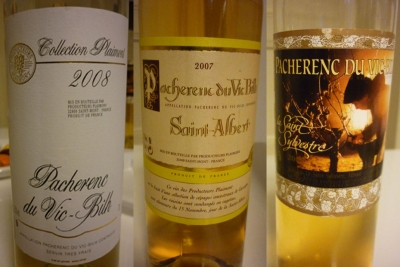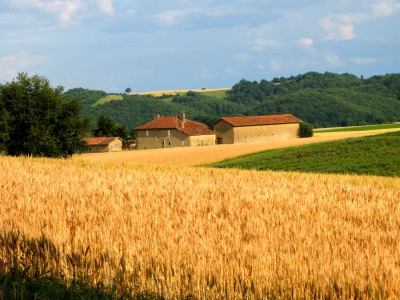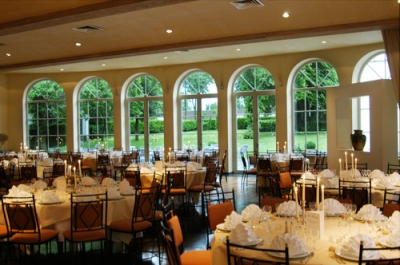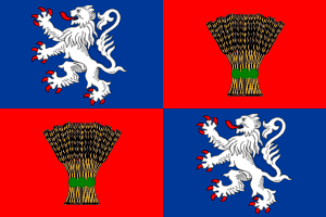
Gas-Can Gascony: Fill ‘Er Up With White! - In Praise Of Pacherenc Du Vic Bilh?
EDWARDS rediscovers white wine while house-sitting a 15-century farmhouse in the Gers, where he can fill up straight from the local producteurs in plastic jerry cans. . . .
While I was house-sitting for three months in a 15th-century farmhouse in Gascony, with a stupefying backyard view of the snow-capped Pyrenees, I finally redeveloped a taste for white wine. But not just any white wine. In the rugged pastoral land that was the battlefield for “The Hundred Years War”--which was neither really a war nor did it last one hundred years--dominated by red AOC Madiran and VDQS Cote de St. Mont, I found myself addicted instead to a whimsical white mouthwash of unpronounceable syllables: “Pacherenc du Vic Bilh!”

Pacherenc du Vic Bilh!”
Introducing the white wine chilling to my neighbor Kevin, a British wanderer then employed by “T,” an Anglo-Irish Earl renovating a chateau nearby in the French departément of Gers, I stood awaiting his verdict. “Wow!” He drained the glass. “Gorgeous, absolutely gorgeous.” I filled his glass again. Again: “Gorgeous, absolutely gorgeous.” We had spent many hours together drinking Gascon wines, available in plastic jerry cans straight from the “producteurs,” while dreaming aloud to the starry asterixes in the night sky over this charmed rural demesnes, filled with medieval fortified towns called “bastides” and castelnaux.” Since during various wars, Gascons fought on the British side, we both felt like honorary “vrai gascognes” (real Gascons) in their signature yellow-mud-covered Wellingtons and beret-basques.
One shot of “White Armagnac” (unaged) and we were no longer tourists. Unfortunately, Kevin, who used to be in a band with the merry prankster “Django Edwards” (no relation to me that I know of) told me that “T” had just fired him and asked if he could camp out on my land. I remembered a while back to when Kevin and his French wife had invited us over for dinner, which inevitably turned into a conversation about travel. The topic was rudely interrupted by a cleaver thwack into a cutting board: Chop! “Am I right that we are both happy just staying here at the chateau?” Kevin scolded his wife severely. Now I could tell by Kevin’s wife’s absence and the wild look in his eyes that a breakup was imminent. What would I do now? I settled upon, “I’m really sorry, Kevin, but I can’t let you stay without the Bray’s permission, and also ‘T’ comes over frequently to check up on us.” I could tell Kevin was on the very edge of going loco. “Also, my friends, Mox and Jox, are coming for a visit,”

15th-century farmhouse in Gascony
I added as an aperitif. Kevin looked madder than hell, but stiffly thanked me for the gift bottle of “Pacherence du Vic Bilh” anyway. “Be careful,” he warned cryptically in farewell, shaking the bottle. “There are poisonous adders everywhere!” (I’m a big fan of “Black Adder.”) When Mox and Jox eventually arrived, I told them about the “sitch” with Kevin, and after discovering the remains of a campfire on the blasted heath of land we were temporarily lording over, we speculated wildly whether Kevin might be hiding out here.
In case Kevin was spying on us we began referring to him as “Tim,” wondering if we were going to end up as victims in a B horror film involving vampire viniculturists—an idea for a short story I’m working on called “Vendage.” For the Welcome Meal, we dined “al fresco” (outside) on fresh Foie Gras and “Magret de Canard” (invented by nearby master-chef Andre Daguin at the Hotel de France in Auch), with roasted potatos and carrots. Although, the meal was paired with a red “fut de chen neuf” (new oak casked) Madiran obtained from the nearby Producteurs de Plaimont, I went inside and returned with the coup de gras: a bottle of friendly “Pacherenc du Vic Bilh.”
We had a field day, spittalking the satisfying collison of sounds: “Pacherenc du Vic Bilh! Pacherence du Vic Bilh!” Jox felt so free out here in the countryside, that she peed on the lawn. Then we downed several bottles of locally produced Armagnac, which unlike Cognac being distilled twice, is put through the alembic (from the Arabic “el embic”) only once. Armagnac is Gascony’s real claim to fame, the best being Bas Armagnac, and we enthusiastically took our chances with the other side of sleep. The next day, I made the mistake of taking Mox and Jox to one of our favorite local eateries in Plaisance called “The Ripa Alta.”

The Ripa Alta Restaurant - Plaisance
The master-chef Coscuella, who had a likeable stutter and a Michelin rosette, made us a special dish: pig’s feet with truffles. Jox, drunk as a sanglier, began complaining, “No way, disgusting, I’m not going to eat that!” “Jox, shh! We eat here all the time; we have to live here!” As if in just-desserts revenge for taking on a Michelin-rosetted restaurant serving four-course art to farmers with a famine of francs, Jox screamed like Janet Leigh in “Psycho” when the hot water heater at our beloved “Ferme Lasserre” conked out. The Anglo-Irish Earl “T” (one of whose ancestors was once the Viceroy of India) came to fix it. His wife handed me a business card: “The Countess de Mayo”: she dabbled in real estate, mostly small chateaux.
Not bad, having royalty at your disposal like that! “Pacherenc du Vic Bilh!” “Pacherenc du Vic Bilh!”






